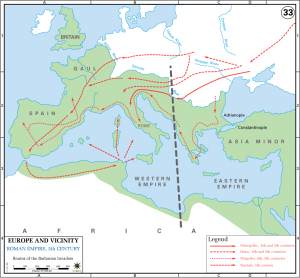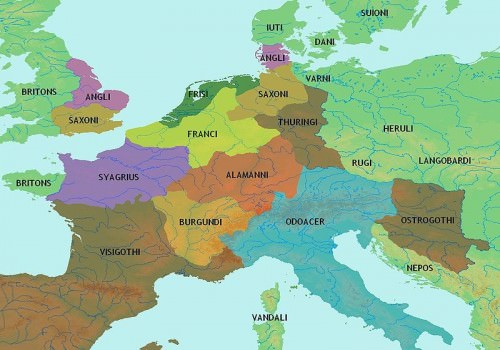The Dissolution of the Empire
 The two halves of the empire continued to prosper equally until the
reign of the Emperor Theodosius I (379 – 395 CE) when internal and
external forces exerted themselves to break the two halves apart. These
forces included, but were not limited to: the excessive zeal of
Theodosius I in spreading Christianity
and stamping out pagan practices; corruption of the ruling class;
incursions by Germanic tribes; and over-extension of boundaries and
resources. The Gothic War of
376-382 CE severely weakened the Western Empire even though the battles
were routinely fought by forces from the Eastern Empire. At the Battle of Adrianople in 378 CE, the Eastern Emperor Valens was defeated by Fritigern of the Goths and
many historians agree that this marks the beginning of the end of the
Roman Empire. A steady decline in power and prestige , however, had been
on-going prior to the Roman defeat at Adrianople and other historians
claim that this culminated in the last Roman Emperor, Romulus Augustus, being deposed by the Germanic king Odoacer on 4 September 476 CE, prior to Adrianople. Regarding the end of the empire, the historian Guy Halsall writes:
The two halves of the empire continued to prosper equally until the
reign of the Emperor Theodosius I (379 – 395 CE) when internal and
external forces exerted themselves to break the two halves apart. These
forces included, but were not limited to: the excessive zeal of
Theodosius I in spreading Christianity
and stamping out pagan practices; corruption of the ruling class;
incursions by Germanic tribes; and over-extension of boundaries and
resources. The Gothic War of
376-382 CE severely weakened the Western Empire even though the battles
were routinely fought by forces from the Eastern Empire. At the Battle of Adrianople in 378 CE, the Eastern Emperor Valens was defeated by Fritigern of the Goths and
many historians agree that this marks the beginning of the end of the
Roman Empire. A steady decline in power and prestige , however, had been
on-going prior to the Roman defeat at Adrianople and other historians
claim that this culminated in the last Roman Emperor, Romulus Augustus, being deposed by the Germanic king Odoacer on 4 September 476 CE, prior to Adrianople. Regarding the end of the empire, the historian Guy Halsall writes:
The most ironic thing of all is that during the preceeding century it
is almost impossible to identify a single figure who had actually tried
to cause its demise. All the decisive acts in bringing down the Empire
were carried out by people attempting to create a better position for
themselves within the sorts of imperial structures that had existed in
the fourth century. In a famous dictum, Andre Piganiol wrote that `Roman
civilisation did not die a natural death; it was assassinated.' Neither
althernative seems correct. The Roman Empire was not murdered and nor
did it die a natural death; it accidentally committed suicide (283).
His suspicions were confirmed when Odoacer was found to be backing Zeno's rival, the general Illus, in a revolt. Zeno employed the Gothic leader Theodosius to defeat Illus but then Theodosius turned his formidable army on Zeno and Constantinople. Halsall writes, "the Goths theatened Constantinople and ravaged the Balkans but could not take the capital, whilst Zeno, secure behind the city's famous triple line of walls, was unlikely to drive the latter completely from his territories. A solution was required, agreeable to both parties, and found: for Theodoric's Ostrogoths to move to Italy and dispose of the `tyrant' Odoacer" (287). Theodoric invaded Italy at the head of his army in 488 CE and battled the forces of Odoacer across the region for the next four years. A compromise was finally brokered by John, Bishop of Ravenna, by which Odoacer and Theodoric would jointly rule but, at the feast to celebrate the end of hostilities in 493 CE, Theodoric assassinated Odoacer and claimed the kingship for himself. From Odoacer to Theodoric and onwards, the Western Roman Empire became the Kingdom of Italy, fully under the control of Germanic or Frankish rulers.
 As Christianity had been legitimized and spread under Roman rule,
there were many Christians who refused to let the Roman Empire die so
easily. Charlemagne of the Franks was proclaimed Western Roman Emperor
in 800 CE by Pope Leo III and entrusted with the charge of protecting
and perpetuating the Christian message. Many tales and poems, including
the famous Chanson de Roland (the Song of Roland), were written
praising Charlemagne and his knights for their chivalrous adventures
defending Christian values. This Christian empire claimed to be the
direct descendant of the old Roman Empire only championing the cause of
Christ instead of that of an individual emperor.
As Christianity had been legitimized and spread under Roman rule,
there were many Christians who refused to let the Roman Empire die so
easily. Charlemagne of the Franks was proclaimed Western Roman Emperor
in 800 CE by Pope Leo III and entrusted with the charge of protecting
and perpetuating the Christian message. Many tales and poems, including
the famous Chanson de Roland (the Song of Roland), were written
praising Charlemagne and his knights for their chivalrous adventures
defending Christian values. This Christian empire claimed to be the
direct descendant of the old Roman Empire only championing the cause of
Christ instead of that of an individual emperor.
The official beginning of the new empire, however, dates from 962 CE when Otto I of Germany was crowned King of Germany and proclaimed his realm The Holy Roman Empire of Germany. Otto I continued the policies of maintaining a Christian nation following Charlemagne’s example. The Holy Roman Empire continued to see itself in this role as an entity championing truth until, through a slow decline involving political intrigue, almost incessant war and constant internal strife, it was dissolved in 1806 CE following defeat by Napoleon Bonaparte. The famous French writer, Voltaire, is quoted as saying in 1756 CE, “This agglomeration which was called and which still calls itself the Holy Roman Empire was neither holy, nor Roman, nor an Empire” and historians since Voltaire have agreed. The Holy Roman Empire was so in name only and after the last mperor, Francis II, abdicated the throne, Napoleon disassembled the existing political structure which supported said name and the territory came under French control through the Confederation of the Rhine.
The Kingdom of Italy
While 476 CE is the traditionally accepted date for the end of the Western Roman Empire, that entity did continue on under the rule of Odoacer who, officially anyway, was simply ruling in place of the deposed emperor Julius Nepos (who had been deposed by the general Orestes who had placed his son, Romulus Augustulus, on the throne). Therefore, there are still other historians and scholars who date the end of the Roman Empire to the assassination of Julius Nepos in 480 CE. After Nepos' death, Odoacer annexed the region of Dalmatia to his own lands which concerned the emperor of the eastern part of the empire, Zeno, by whose authority Odoacer had been allowed to rule. In Zeno's view, Odoacer was acting with too much independent authority and was beginning to pose a significant threat.His suspicions were confirmed when Odoacer was found to be backing Zeno's rival, the general Illus, in a revolt. Zeno employed the Gothic leader Theodosius to defeat Illus but then Theodosius turned his formidable army on Zeno and Constantinople. Halsall writes, "the Goths theatened Constantinople and ravaged the Balkans but could not take the capital, whilst Zeno, secure behind the city's famous triple line of walls, was unlikely to drive the latter completely from his territories. A solution was required, agreeable to both parties, and found: for Theodoric's Ostrogoths to move to Italy and dispose of the `tyrant' Odoacer" (287). Theodoric invaded Italy at the head of his army in 488 CE and battled the forces of Odoacer across the region for the next four years. A compromise was finally brokered by John, Bishop of Ravenna, by which Odoacer and Theodoric would jointly rule but, at the feast to celebrate the end of hostilities in 493 CE, Theodoric assassinated Odoacer and claimed the kingship for himself. From Odoacer to Theodoric and onwards, the Western Roman Empire became the Kingdom of Italy, fully under the control of Germanic or Frankish rulers.
Central Europe 5th century CE
The Holy Roman Empire
 As Christianity had been legitimized and spread under Roman rule,
there were many Christians who refused to let the Roman Empire die so
easily. Charlemagne of the Franks was proclaimed Western Roman Emperor
in 800 CE by Pope Leo III and entrusted with the charge of protecting
and perpetuating the Christian message. Many tales and poems, including
the famous Chanson de Roland (the Song of Roland), were written
praising Charlemagne and his knights for their chivalrous adventures
defending Christian values. This Christian empire claimed to be the
direct descendant of the old Roman Empire only championing the cause of
Christ instead of that of an individual emperor.
As Christianity had been legitimized and spread under Roman rule,
there were many Christians who refused to let the Roman Empire die so
easily. Charlemagne of the Franks was proclaimed Western Roman Emperor
in 800 CE by Pope Leo III and entrusted with the charge of protecting
and perpetuating the Christian message. Many tales and poems, including
the famous Chanson de Roland (the Song of Roland), were written
praising Charlemagne and his knights for their chivalrous adventures
defending Christian values. This Christian empire claimed to be the
direct descendant of the old Roman Empire only championing the cause of
Christ instead of that of an individual emperor.The official beginning of the new empire, however, dates from 962 CE when Otto I of Germany was crowned King of Germany and proclaimed his realm The Holy Roman Empire of Germany. Otto I continued the policies of maintaining a Christian nation following Charlemagne’s example. The Holy Roman Empire continued to see itself in this role as an entity championing truth until, through a slow decline involving political intrigue, almost incessant war and constant internal strife, it was dissolved in 1806 CE following defeat by Napoleon Bonaparte. The famous French writer, Voltaire, is quoted as saying in 1756 CE, “This agglomeration which was called and which still calls itself the Holy Roman Empire was neither holy, nor Roman, nor an Empire” and historians since Voltaire have agreed. The Holy Roman Empire was so in name only and after the last mperor, Francis II, abdicated the throne, Napoleon disassembled the existing political structure which supported said name and the territory came under French control through the Confederation of the Rhine.

No comments:
Post a Comment